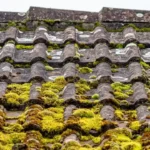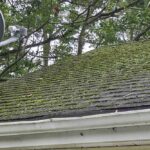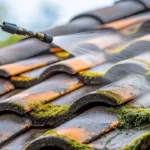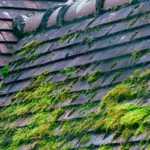Living in mountain areas provides breathtaking views and a serene lifestyle. However, homeowners in these regions face a unique challenge: roof moss. The lush, moist environment of mountain areas creates the perfect conditions for moss to thrive. Understanding how to manage and prevent moss growth is crucial for maintaining a healthy roof.

Understanding Roof Moss
Roof moss is a type of non-vascular plant that grows in damp, shaded environments. It can appear as a green carpet on rooftops, especially in mountain regions where moisture is prevalent. While it might look picturesque, moss can cause significant damage to roofs if left unchecked.
Why Does Moss Grow on Roofs?
Moss grows on roofs primarily because of the moisture and shade provided by trees and the mountainous environment. These conditions allow moss spores to settle and thrive. The texture of roofing materials like shingles can also offer a suitable surface for moss to anchor itself.
The Impact of Moss on Roofs
Moss can retain moisture against roof surfaces, leading to the deterioration of roofing materials over time. This moisture can seep into the roof structure, causing leaks and potentially leading to mold growth inside the home. Additionally, moss can lift shingles, creating gaps where water can enter.
Preventing Roof Moss
Regular Roof Inspections
Conducting regular roof inspections can help in early detection of moss growth. This proactive approach allows homeowners to address the issue before it escalates, saving time and money in the long run.
Trimming Overhanging Branches
One effective way to prevent moss growth is by trimming overhanging tree branches. This increases sunlight exposure on the roof, reducing the shade that moss needs to thrive. Additionally, fewer branches mean less organic debris on the roof, which can contribute to moss growth.
Maintaining Proper Drainage
Ensuring that gutters and downspouts are clear and functioning correctly is vital. Proper drainage helps to prevent water from pooling on the roof, reducing the likelihood of moss growth. Regularly clearing debris from gutters can aid in maintaining effective water flow.
Removing Roof Moss
DIY Methods
Homeowners can opt for DIY approaches to remove moss. This includes using a scrub brush and a mixture of water and mild detergent to gently scrub away the moss. It’s crucial to be cautious and avoid using high-pressure washers that can damage roofing materials.
Professional Cleaning Services
For extensive moss growth, hiring professional roof cleaning services is recommended. Professionals have the expertise and equipment to safely and effectively remove moss without causing harm to the roof. They can also apply preventative treatments to inhibit future growth.
Long-Term Solutions
Installing Zinc or Copper Strips
Installing zinc or copper strips along the roof’s ridge can be an effective long-term solution. When it rains, the metal ions are released, inhibiting moss growth. This is a cost-effective way to maintain a moss-free roof.
Choosing Moss-Resistant Roofing Materials
When replacing a roof, consider using moss-resistant shingles. These are designed to resist moss growth and can be particularly beneficial in mountain areas. Investing in these materials can save homeowners from future moss-related issues.
The Cost of Ignoring Moss
Ignoring moss on a roof can lead to significant repair costs. The damage caused by moisture retention and shingle displacement can compromise the roof’s integrity. Addressing moss growth promptly helps in avoiding costly repairs and potential health hazards such as mold.
Conclusion
For homeowners in mountain areas, managing roof moss is an essential aspect of home maintenance. By understanding the causes and effects of moss growth, as well as employing preventative measures and removal strategies, homeowners can protect their investment and ensure their roof’s longevity. For more detailed guidance, check out this expert advice on roof maintenance.

FAQ
How often should I check my roof for moss?
It’s advisable to inspect your roof at least twice a year, especially after the wet season.
Can I use household bleach to remove moss?
While bleach can kill moss, it may also damage roofing materials. It’s best to use products specifically designed for roofs.
Is moss growth covered by homeowner’s insurance?
Typically, damage caused by moss is not covered by insurance as it is considered a maintenance issue. Regular upkeep is essential.
This article contains affiliate links. We may earn a commission at no extra cost to you.








